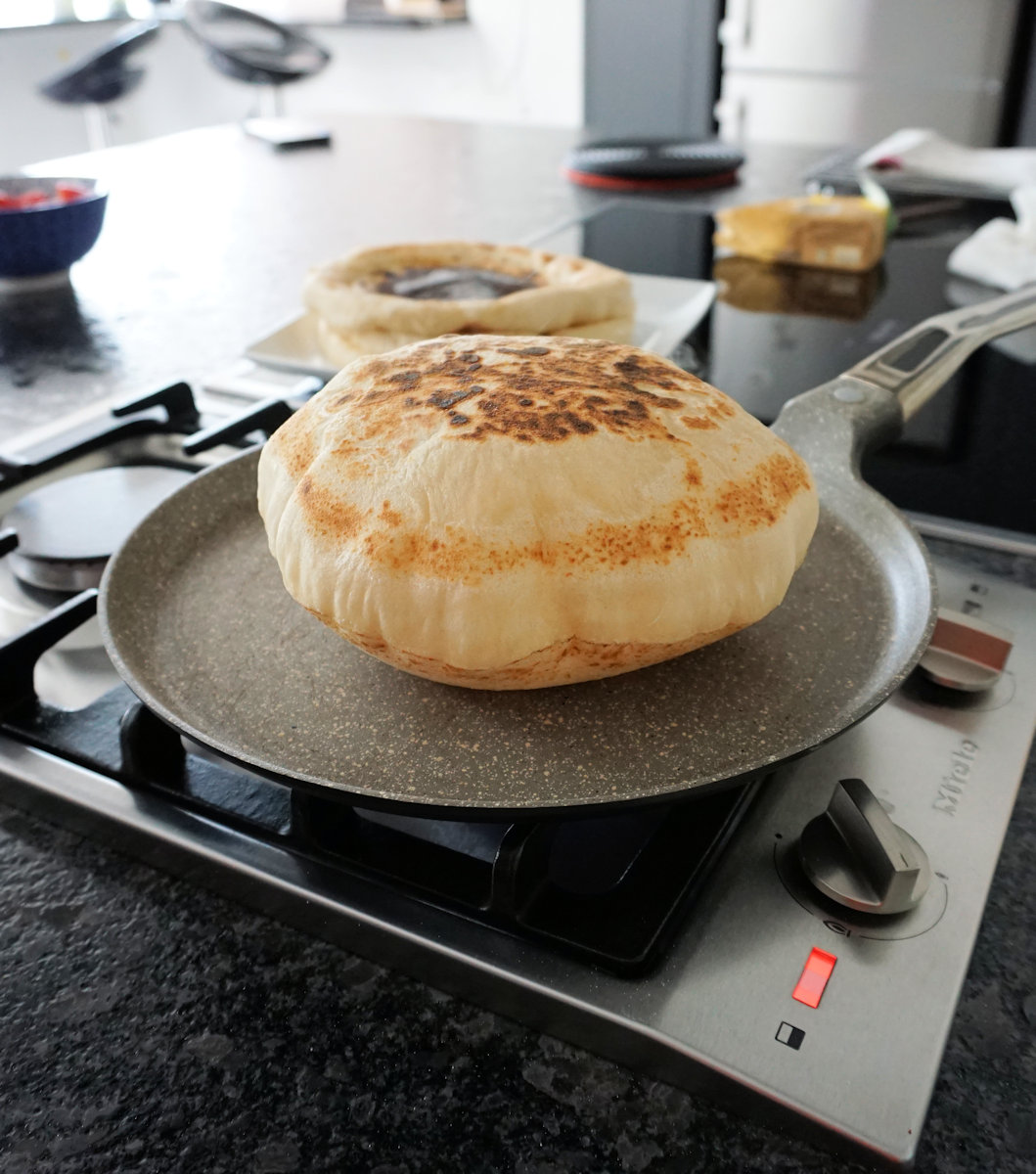See it rise and inflate like a weird, edible alien space ship in your frying pan! That’s bazlama, Turkish flatbread which is anything but flat when cooking.

What is bazlama?
Bazlama is a traditional Turkish flatbread known for its fluffy texture, distinct flavour, and versatility in the kitchen.
Bazlama has a rich history dating back centuries in Anatolian cuisine. Originating from the nomadic Turkic tribes of Central Asia, this bread gained popularity during the Seljuk and Ottoman periods.
It was traditionally prepared and enjoyed by Turkish shepherds during their journeys, making it a symbol of simplicity, resilience and resourcefulness.
How to make bazlama?
Bazlama is made from a simple dough of flour, water and yoghurt, salt and yeast. Unlike other breads, it does not require an extensive rising period, making it a convenient choice for time-sensitive meals.
The dough is gently kneaded to achieve a soft, pliable consistency, allowing for huge air pockets to develop during the cooking process. You should add the flour gradually, and as flours, water and weathers differ, you might not use up all the flour, making sure that the dough is very soft and just past the point of sticky.
Cooking methods
Bazlama is traditionally cooked on a sac, a convex griddle made of cast iron or steel, placed over an open fire. It looks a little like a wide, shallow Dutch oven.
The heat source can vary from wood, charcoal or gas, imparting a distinct smoky aroma and flavour to the bread. The sac 's concave shape promotes even cooking, resulting in a fluffy interior and a golden brown exterior.
At home, you need to use a frying pan, heavy and sturdy but not necessarily cast iron. A crepe pan works very well.
The way bazlama cooks is spectacular: flat at first, then bubbling like a dormant volcano only to finally rise and inflate like a weird bread balloon!
When you first place the dough on the preheated pan, wait about 1 minute for the bubbles to appear. Flip it over and wait a minute again. It should start to inflate across the breadth, the top surface of the dough ballooning steadily, but if it doesn’t happen flip the bazlama again – and then it is sure to go.
Off the pan, it wants to be brushed with butter before stacking with the next one, so they don’t stick to each other – and for the taste too.
How to serve bazlama?
Bazlama is a versatile bread that pairs well with various dishes and accompaniments.
Its pillowy texture and subtle flavour make it an excellent choice for mopping up rich stews, dipping into flavourful sauces, or serving alongside grilled meats and vegetables, like kebabs or shawarmas.
It can also be used as a base for sandwiches, wraps or even as a pizza crust alternative.
It is best warm, freshly cooked but you can wrap one or a stack in foil and warm it up in the oven. It also freezes well and can be toasted in the oven from frozen.
Variations and regional influences
While the basic recipe for bazlama remains consistent, there are regional variations that showcase the diversity of Turkish cuisine.
For instance, in Anatolia yogurt or buttermilk is added to the dough, resulting in a tangy flavour profile – which is what inspired Ayla’s recipe that I followed.
Other regions make their bazlama dough plain, unriched with any dairy, just flour and water. Plus, herbs such as mint, parsley or dill can be incorporated, adding a refreshing twist to the bread.
Traditional and modern accompaniments
Bazlama is a big player in Turkish mezes, to be broken into chunks and loaded with hummus, baba ganoush or muhammara.
Olive oil, black and green olives and cheese varieties like feta or beyaz peynir are popular accompaniments.
It is also the best possible wrap for a lamb or chicken shawarma.
For a modern twist, you can experiment with contemporary spreads, dips and toppings, creating innovative flavour combinations.
Bazlama is a treasured part of Turkish culinary heritage, with ekmek, gözleme and pide. It’s also a marvellous addition to the range of world’s flatbreads and, in my books, a serious rival to pita.
More flatbread recipes
Fougasse with grated Emmental cheese, chewy and crispy French flatbread is the cousin of Italian focaccia. Make it with sourdough starter or bakers’ yeast – equally delicious and not at all difficult.
Lavash, Middle Eastern flatbread often served with dips or kebabs is easy to make and cook on the hob in a frying pan with a little ghee.
Plain focaccia with rosemary and salt flakes: easy to make, divine to eat, warm or cold. Authentic Ligurian recipe from Samin Nosrat’s Salt, Acid, Fat, Heat.
More meze recipes
Oven cooked chicken shawarma, fragrant with spices, is made from chicken thigh pieces marinated overnight and threaded on skewers. Serve with a warm flatbread for the home-cooked equivalent of beloved Middle Eastern street food.
Discover the rich history and versatility of kibbeh pie, a traditional Middle Eastern comfort food loved by many, and try out a tasty recipe for yourself!
Persian cucumber and radish salad, sabzi khordan, is the healthiest plate imaginable. Sabzi khordan means 'eat your greens' and it's piled high with fresh herbs over sliced cucumber and radish.